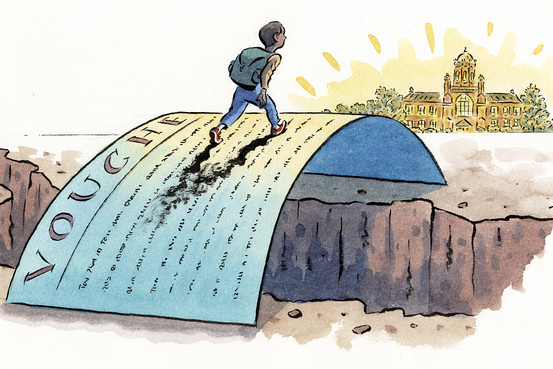There is a growing consensus that long term economic growth requires investment in human capital to augment labour productivity, which naturally directs one to education, as the greatest enabler. There has been a definite increase in enrolment rates across the country and for all practical purposes we’ve viewed enrolment rates as our evaluation criteria and have completely ignored if the quality of education has improved over time or not. While some authors argue that a potential solution to this problem is greater outlay on primary education, they ignore the fact that even where adequate funding is provided for primary education, the quality remains poor. With teachers absent, lack of labs, lack of sports and recreational facilities our public education system has become a dumping ground of public resources.
A major reason behind this is the fact that India’s education system that caters to the needs of the poor in monopolistic- that is, since the poor have little ability to pay for education, only the public sector caters to their needs. A direct consequence of this is that the poor lack any choice in terms of deciding the service provider for their education needs. This lack of choice or lack of competition results in complacency with the monopolist (or the government) in terms of providing or improving the quality of education service.
It is equally important to find an innovative way to address the critical challenges that India’s public schooling system faces. An alternative approach towards public education system comes from a clear separation between the provider and the financier of the service; that is, while the government may continue to finance the education system, it need not run its own schools to provide education. This is possible in a system where the funds follow the students rather than school. Friedman (1955) proposed moving to a voucher system for primary and secondary education in the United States of America.
Under such a system, the government would provide the students with education vouchers of a fixed amount and the student can use it towards paying their fee at any school of their choice. By providing this direct voucher in India, the Indian government can actually expand the market of primary and secondary education for the poor and low-income groups as these vouchers would act as an incentive for private entrepreneurs to set up good quality low-cost schools. Thus, while financing of education will be done by the government, production of the service under such a system can be done by either the public sector or the private sector. Over time, this move would enable healthy competition between public and private sector which should increase the efficiency of the public education system. With the funds following the students, it would be a must for public schools to provide quality education or else the students could now easily move to an alternative school.
Additionally, a voucher system must be viewed as a consumption subsidy which would be in contrast with the current system which is a production subsidy, that is, under this system, the student gets the subsidy if he/she enrolls in an education system rather than the state government providing heavily subsidised education. This also throws up interesting opportunities in designing an education voucher program for India that may be critical towards improving education outcomes. For instance, the voucher value can have an added bonus that can be provided to students who have an attendance greater than 80 per cent. Another important aspect of designing the scheme could be towards the disabled who require special assistance and thus, they must be provided with a higher voucher value than other students. Progressive nature of vouchers, combined with annual stipends will also help in improving retention rates in schools.
The government can set up a minimum standard for schools and establish a comprehensive randomized system for standardised tests to assess the performance of the schools based on education outcomes. This will help in mapping districts that may require additional financial help to improve outcomes.
The education vouchers system is currently in place in several countries in different forms. In the case of Chile, West (1996) observes that post introduction of the Voucher System in 1987, there was a considerable increase in the number of students attending private schools, given its superior quality. The reforms had also, in fact, led to an increase in the overall duration of education received by the Chilean population and it led to a substantial drop in the illiteracy rates amongst the youth.
In India, the Delhi Voucher Project was undertaken by the Centre for Civil Society (CCS). Under the project, they awarded school education vouchers to 408 underprivileged students in Delhi for a minimum of 3 years. These vouchers were made directly available to the schools to meet the student’s expenditure towards fees, books, uniforms etc. They reviewed the experiment and presented the key findings in their Delhi Voucher Project First Assessment Report (CMS & CCS, 2009). The report found that 63.1% of the voucher beneficiaries exercised freedom of choice and thus switched to private schools and more than 90% of parents of the students who switched to private schools (due to vouchers) were happy with the progress their children made, their teachers and standards of discipline in these schools.
Therefore, there is ample evidence that the voucher system performs better than the conventional production subsidy. India could learn from the global experience and consider moving towards a voucher system as a policy tool towards expansion and improvement of the quality of India’s public primary and secondary education system.
Read more about Education Vouchers: https://spontaneousorder.in/equity-in-education/
The article is from a detailed paper that investigates the possibility of a targeted education voucher program for India. The paper can be accessed by clicking here.
Post Disclaimer
The opinions expressed in this essay are those of the authors. They do not purport to reflect the opinions or views of CCS.






